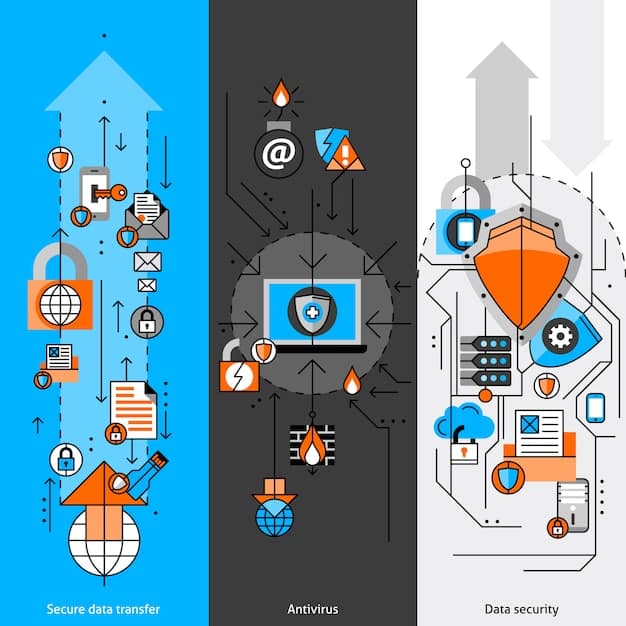Cybersecurity for Businesses: Safeguarding Digital Assets

Advertisements
Effective cybersecurity for businesses involves proactive strategies, robust technological implementatations, and continuous employee training to safeguard digital assets and maintain operational integrity in the face of evolving cyber threats.
Advertisements
In an era defined by ubiquitous digital transformation, the importance of Cybersecurity for Businesses: Protecting Your Assets in an Increasingly Digital World has never been more pronounced. As companies increasingly rely on digital infrastructures for operations, data storage, and customer interactions, they become prime targets for malicious actors. Understanding and mitigating these risks is not merely an IT concern, but a fundamental business imperative impacting reputation, financial stability, and long-term viability.
Advertisements
The Evolving Threat Landscape: Why Cybersecurity is Critical Now
The digital realm presents a constantly shifting battleground, where cyber threats evolve with alarming speed and sophistication. Businesses, regardless of size or industry, face a myriad of risks that can cripple operations, compromise sensitive data, and erode customer trust. Understanding this dynamic landscape is the first step toward building a resilient defense.
Cybercriminals are no longer just lone hackers; they are often organized groups, even state-sponsored entities, employing advanced tactics. Their motivations range from financial gain through ransomware and data theft to industrial espionage and intellectual property theft. The sheer volume and variety of attacks mean that an “it won’t happen to us” mentality is a dangerous delusion that many businesses simply cannot afford to entertain in today’s interconnected world.
Common Cyber Threats Businesses Face
Businesses must contend with a diverse array of threats, each requiring a specific approach to mitigation. Awareness of these common attack vectors is crucial for developing a comprehensive security strategy.
- Ransomware: This malicious software encrypts a victim’s files, with the attacker demanding a ransom payment (usually in cryptocurrency) for decryption. It can bring operations to a complete halt.
- Phishing and Spear Phishing: Social engineering tactics used to trick employees into revealing sensitive information, such as passwords or financial details, often through deceptive emails or messages.
- Malware and Viruses: Broad categories of malicious software designed to damage, disable, or gain unauthorized access to computer systems and data without the user’s knowledge.
Beyond these, businesses also contend with insider threats, whether malicious or accidental, and distributed denial-of-service (DDoS) attacks aimed at disrupting online services. Each vector represents a potential vulnerability that, if exploited, can lead to severe consequences for the organization.
The Consequences of a Cyber Attack
A successful cyber attack can inflict far-reaching damage beyond immediate financial losses. The ripple effects can be long-lasting and severe, impacting multiple facets of a business’s health and future prospects.
Financial repercussions are often the most immediate. These include costs associated with incident response, data recovery, regulatory fines, and legal fees. Operational downtime can lead to significant revenue loss, particularly for businesses that rely heavily on digital systems for their core services. The disruption can be prolonged, affecting supply chains and customer fulfillment. Furthermore, the erosion of customer trust and reputational damage can have an enduring impact, making it difficult to attract new clients and retain existing ones.
The regulatory landscape is also becoming increasingly stringent, with laws like GDPR and CCPA imposing hefty penalties for data breaches. Non-compliance can result in substantial fines, further exacerbating the financial burden of an attack. In essence, cybersecurity is no longer an optional add-on; it is a foundational element of sound business governance, essential for risk management and ensuring continued operations.

Developing a Robust Cybersecurity Strategy
Building an effective cybersecurity strategy requires more than just installing antivirus software; it demands a holistic approach that integrates technology, policy, and human factors. A well-designed strategy is proactive, adaptive, and focused on protecting all critical assets.
The foundation of any strong strategy is a thorough understanding of an organization’s most valuable assets and the specific threats they face. This involves conducting comprehensive risk assessments to identify vulnerabilities, prioritize risks, and allocate resources effectively. It’s about creating a layered defense, where multiple security controls work in concert to protect systems and data, rather than relying on a single point of failure.
Key Pillars of a Comprehensive Strategy
An effective cybersecurity framework typically rests on several interconnected pillars, each contributing to the overall security posture and resilience of the organization. Ignoring any of these components can create a significant weakness in the defensive perimeter.
- Risk Assessment and Management: Continuously identifying, evaluating, and prioritizing cyber risks to allocate resources effectively and develop appropriate mitigation strategies. This is an ongoing process, not a one-time event.
- Technical Controls Implementation: Deploying essential security technologies such as firewalls, intrusion detection/prevention systems (IDS/IPS), endpoint protection, and data encryption.
- Access Management: Implementing strong authentication measures (e.g., multi-factor authentication, MFA), strict access policies based on the principle of least privilege, and regular review of user permissions.
Furthermore, regular penetration testing and vulnerability scanning are critical to proactively identify weaknesses before malicious actors can exploit them. The strategy must also include robust data backup and recovery plans to ensure business continuity in the event of a successful attack. This multi-faceted approach ensures that potential threats are anticipated and countered from various angles, providing a higher level of protection than isolated security measures.
Policies and Procedures: The Human Element of Security
Technology alone is insufficient to protect against cyber threats. The human element often represents the weakest link in the security chain, making well-defined policies and procedures, coupled with continuous training, absolutely indispensable.
Clear, enforceable security policies provide employees with guidelines on how to handle sensitive information, use company systems, and identify potential threats. These policies should cover everything from password complexity to acceptable internet usage and incident reporting procedures. Regular, mandatory security awareness training educates employees about the latest threats, such as phishing scams and social engineering tactics, empowering them to become the first line of defense. This training should be engaging and relevant, using real-world examples to illustrate potential risks and best practices. Establishing a culture of security, where every employee understands their role in protecting the organization’s assets, transforms a potential vulnerability into a powerful protective layer.
Essential Cybersecurity Technologies and Tools
To effectively combat the diverse and sophisticated cyber threats of today, businesses must leverage a range of specialized technologies and tools. These serve as the digital fortifications that protect networks, systems, and data from unauthorized access, disruption, and destruction.
Selecting the right suite of tools depends on the specific needs, size, and risk profile of an organization. However, certain core technologies are fundamental to almost any robust cybersecurity posture. These tools work in concert, providing overlapping layers of defense, making it significantly harder for attackers to penetrate an organization’s digital perimeter and access its valuable assets.
foundational Security Technologies
No single tool can provide complete protection; therefore, a layered approach utilizing several key technologies is essential for comprehensive cybersecurity defense. These form the basic building blocks of a secure IT environment.
- Firewalls: Act as barriers between internal networks and external threats, controlling incoming and outgoing network traffic based on predetermined security rules.
- Antivirus and Endpoint Detection & Response (EDR): Protect individual devices (endpoints) from malware, viruses, and other malicious software. EDR goes further, actively monitoring and logging endpoint events to detect and respond to threats in real-time.
- Intrusion Detection/Prevention Systems (IDS/IPS): Monitor network traffic for suspicious activity (IDS) and can automatically block or alert on detected threats (IPS), preventing intrusions before they cause harm.
Beyond these, businesses should also consider data loss prevention (DLP) solutions to prevent sensitive information from leaving the organization’s control, and security information and event management (SIEM) systems, which collect and analyze security logs from various sources to provide a centralized view of an organization’s security posture and alert on potential incidents.
Advanced Tools for Proactive Defense
As threats become more sophisticated, so too must the tools used to defend against them. Advanced cybersecurity technologies focus on proactive defense, threat intelligence, and automated response capabilities, moving beyond reactive measures.
Threat intelligence platforms gather and analyze data on emerging threats, providing businesses with insights into potential attacks specific to their industry or region. Security orchestration, automation, and response (SOAR) platforms automate incident response workflows, allowing security teams to react faster and more efficiently to detected threats, reducing human error and response times. User and entity behavior analytics (UEBA) systems leverage machine learning to detect unusual patterns in user behavior, identifying potential insider threats or compromised accounts that might otherwise go unnoticed. Cloud security posture management (CSPM) tools are becoming increasingly vital for businesses operating in cloud environments, ensuring that cloud configurations meet security best practices and compliance requirements. These advanced tools enable organizations to stay ahead of the curve, anticipating and neutralizing threats before they can cause significant damage.

Cybersecurity Best Practices for Businesses
Implementing effective cybersecurity is an ongoing process that requires adherence to best practices across all levels of an organization. These practices go beyond mere technological solutions, encompassing strategy, processes, and human behavior to create a comprehensive security posture.
Adopting best practices helps businesses build resilience against a constantly evolving threat landscape. It’s about establishing a strong foundation that reduces vulnerabilities, minimizes the impact of potential breaches, and ensures a swift and effective response should an incident occur. These practices, when consistently applied, significantly strengthen an organization’s ability to protect its digital assets and maintain operational integrity.
Fundamental Security Habits
Certain fundamental habits are essential for maintaining a strong cybersecurity posture. These are the basic building blocks upon which more complex security measures are constructed, and their consistent application by all employees is paramount.
- Regular Software Updates and Patching: Keeping all software, operating systems, and applications up-to-date is crucial, as updates often include critical security patches that address newly discovered vulnerabilities.
- Strong Password Policies and MFA: Enforcing complex password requirements and mandating multi-factor authentication significantly reduces the risk of unauthorized access due to compromised credentials.
- Data Backup and Recovery: Regularly backing up critical data and having a tested disaster recovery plan ensures business continuity even if data is lost, corrupted, or held for ransom.
Additionally, segmenting networks can help contain breaches by isolating compromised systems from the rest of the network. Implementing a least privilege approach, where users only have access to the resources absolutely necessary for their job functions, minimizes the potential damage from a compromised account. These habits, though seemingly minor, collectively contribute to a robust defense against various cyber threats.
Incident Response and Business Continuity Planning
Even with the most robust defenses, no organization is entirely immune to cyber incidents. Having a well-defined incident response plan and a comprehensive business continuity strategy is crucial for minimizing damage and ensuring a swift recovery.
An incident response plan outlines the steps an organization will take from the moment a security incident is detected until it is contained, eradicated, and recovered from. This includes clear roles and responsibilities, communication protocols, and technical procedures for forensic analysis and containment. Regular testing of this plan, through simulations and drills, ensures that the team can execute effectively under pressure. Business continuity planning goes a step further, focusing on maintaining essential business functions during and after a security incident. This includes identifying critical systems and processes, developing alternative operational procedures, and ensuring data availability through robust backup and recovery solutions. A well-prepared organization can mitigate the impact of an attack, recover quickly, and continue serving its customers, safeguarding its reputation and financial stability.
The Human Factor in Cybersecurity: Training and Awareness
While technology provides powerful tools for defense, the human element remains a critical component of any cybersecurity strategy. Employees, if not properly trained, can inadvertently become the weakest link, leading to devastating breaches. Conversely, a well-informed workforce can serve as a strong line of defense.
Investing in comprehensive cybersecurity training and fostering a strong security awareness culture is no longer an option but a necessity. It’s about empowering every individual within the organization to recognize and report threats, reinforcing the idea that security is everyone’s responsibility, not just the IT department’s. This cultural shift transforms potential vulnerabilities into active contributors to the organization’s overall security posture, creating a more resilient and vigilant environment.
Building a Security-Aware Culture
Creating a security-aware culture involves more than just annual training sessions; it requires continuous education, clear communication, and leadership buy-in. It’s about integrating security into the daily operations and mindset of every employee.
- Regular Training Segments: Implement frequent, engaging training modules that cover evolving threats like new phishing techniques, social engineering tactics, and safe browsing habits.
- Simulated Phishing Attacks: Conduct regular, simulated phishing campaigns to test employee vigilance and identify areas where further training is needed. This provides practical experience in recognizing threats.
- Clear Reporting Mechanisms: Establish an easy and confidential way for employees to report suspicious emails or activities without fear of reprimand, encouraging a proactive approach to security.
Beyond formal training, fostering an open communication channel where employees feel comfortable asking questions about security, and where security updates are shared regularly, helps maintain a high level of awareness. Publicly recognizing employees who report potential threats can also reinforce positive security behaviors, building a collective sense of responsibility and turning every team member into an active participant in protection.
Training for Different Roles
Cybersecurity training should not be a one-size-fits-all approach. Different roles within an organization have varying levels of access to sensitive data and exposure to specific threats, requiring tailored training programs to address their unique risks effectively.
For instance, training for general employees might focus on recognizing phishing emails, strong password practices, and safe internet usage. IT and security teams, however, require highly specialized training on incident response, threat hunting, secure coding practices, and specific security tool functionalities. Executives and management also need dedicated training on the strategic implications of cybersecurity risks, data governance, and their role in championing a security-first culture. Sales and marketing teams, who often handle customer data, require specific guidance on data privacy and ethical data handling. Tailoring the training ensures that each segment of the workforce receives the relevant knowledge and skills to protect the organization’s assets effectively, optimizing the impact of security education efforts.
Compliance and Regulatory Landscape
In the digital age, businesses operate under an increasing burden of regulatory compliance regarding data protection and cybersecurity. Navigating this complex legal landscape is crucial not only for avoiding hefty fines but also for building trust with customers and partners. Adherence to these regulations isn’t merely a checkbox exercise; it reflects a commitment to protecting sensitive information.
Many industries and geographical regions have specific laws and frameworks that dictate how businesses must manage and protect data. Failure to comply can result in severe financial penalties, reputational damage, and even legal action. Therefore, understanding and implementing the necessary controls to meet these requirements is an integral part of a comprehensive cybersecurity strategy, ensuring that operational practices align with legal obligations and industry standards.
Overview of Key Regulations
Businesses often face a patchwork of regulations depending on their industry, location, and the type of data they handle. Awareness and adherence to these key compliance frameworks are essential for avoiding legal and financial repercussions.
- General Data Protection Regulation (GDPR): A landmark EU law governing data protection and privacy for all individuals within the European Union and European Economic Area. It has extraterritorial reach, impacting any business that processes data of EU citizens.
- California Consumer Privacy Act (CCPA) / California Privacy Rights Act (CPRA): State-level laws in California granting consumers significant rights regarding their personal information collected by businesses.
- Health Insurance Portability and Accountability Act (HIPAA): A US law protecting the privacy of patient health information, requiring strict security measures for healthcare providers and their business associates.
Beyond these, sector-specific regulations like PCI DSS (Payment Card Industry Data Security Standard) for handling credit card information, and NIST Cybersecurity Framework for critical infrastructure, further complicate the compliance landscape. Businesses must conduct thorough assessments to identify all applicable regulations and integrate their requirements into their cybersecurity policies and technologies.
Building Compliance into Your Strategy
Achieving and maintaining regulatory compliance is an ongoing process that should be integrated directly into a business’s cybersecurity strategy, rather than treated as a separate, one-off task. This ensures continuous adherence and adaptability.
The first step is to conduct a thorough data inventory, understanding what data is collected, where it is stored, how it is processed, and who has access to it. This mapping is fundamental for identifying which specific regulations apply. Next, businesses should implement robust data governance policies, covering data retention, deletion, and consent management, ensuring they align with regulatory requirements. Conducting regular compliance audits and assessments, both internal and external, helps identify gaps and provides an opportunity to remediate issues before they lead to non-compliance. Furthermore, employee training on specific regulatory requirements is vital, as human error often contributes to breaches. By embedding compliance into every layer of the cybersecurity strategy, organizations can not only avoid penalties but also demonstrate a strong commitment to data protection, enhancing trust with customers and stakeholders in an increasingly privacy-aware world.
Future Trends in Cybersecurity for Businesses
The cybersecurity landscape is in constant flux, driven by technological advancements, evolving attack vectors, and geopolitical dynamics. Staying ahead of these trends is crucial for businesses to maintain effective defenses and anticipate future threats. Proactive adaptation, rather than reactive response, will define the success of cybersecurity strategies in the coming years.
Emerging technologies like Artificial Intelligence (AI) and Machine Learning (ML) are not only being used by defenders for advanced threat detection but are also being weaponized by attackers to create more sophisticated and automated attacks. The expanded attack surface brought about by the Internet of Things (IoT) and the increasing decentralization of work further complicates defense strategies. Understanding these trajectories allows businesses to prepare for upcoming challenges and strategically invest in the right protective measures.
Artificial Intelligence and Machine Learning in Defense
AI and ML are revolutionizing cybersecurity, offering unprecedented capabilities for threat detection, analysis, and response. Their ability to process vast amounts of data and identify subtle patterns makes them invaluable tools in the fight against cybercrime.
AI-powered security solutions can analyze network traffic, user behavior, and system logs in real-time, identifying anomalies that might indicate a cyber attack. This allows for faster detection of sophisticated threats that might elude traditional signature-based detection methods. ML algorithms can also significantly improve endpoint protection by learning about normal system behavior and flagging anything unusual, including zero-day exploits. Furthermore, AI can assist in automating incident response, reducing the time from detection to containment and recovery. However, businesses must also be aware that attackers are also leveraging AI to craft more convincing phishing emails, automate malware generation, and accelerate brute-force attacks. Therefore, the adoption of AI in cybersecurity is a race between offense and defense, emphasizing the need for continuous innovation.
The Rise of Zero Trust Architecture
As traditional perimeter-based security models prove increasingly inadequate against modern threats, the “Zero Trust” security model is gaining widespread adoption. This paradigm shifts the focus from “trust but verify” to “never trust, always verify.”
Zero Trust assumes that no user or device, whether inside or outside the network, should be trusted by default. Every access request is authenticated, authorized, and continuously monitored, regardless of its origin. This involves micro-segmentation of networks, strong identity and access management (IAM), and continuous verification of user and device credentials. For businesses, implementing Zero Trust significantly reduces the risk of insider threats and lateral movement once an attacker gains initial access, as every segment of the network requires separate authorization. While it requires a significant architectural shift, Zero Trust provides a more resilient and adaptable framework particularly suited for hybrid work environments and cloud-based operations, minimizing the impact of potential breaches by containing them effectively.
| Key Point | Brief Description |
|---|---|
| 🛡️ Evolving Threats | Cyber threats are growing in sophistication and volume, necessitating robust and adaptive defense strategies for all businesses. |
| ⚙️ Layered Defense | Effective security combines technical tools like firewalls and EDR with strong policies and access management. |
| 🧑💻 Human Element | Employee training and a culture of security are crucial to turn staff into proactive defenders, reducing the risk of human error. |
| uture Trends | AI, ML, and Zero Trust models are shaping the future of cybersecurity, demanding continuous adaptation and investment from businesses. |
Frequently Asked Questions
▼
Cybersecurity for businesses entails the practices, technologies, and processes designed to protect computer systems, networks, and data from digital attacks, damage, or unauthorized access. It aims to safeguard sensitive information, ensure business continuity, and maintain system integrity against a range of evolving cyber threats, crucial in today’s digital operational landscape.
▼
Cybersecurity is vital for businesses to protect their valuable digital assets, customer data, and intellectual property from theft, damage, or disruption. A strong cybersecurity posture helps prevent financial losses from breaches, maintains customer trust, ensures compliance with regulations like GDPR and HIPAA, and guarantees operational continuity, all critical for long-term success and reputation.
▼
Businesses commonly face threats such as ransomware, which encrypts data for ransom; phishing and spear phishing, which trick employees into divulging sensitive information; and various forms of malware including viruses, trojans, and spyware. Additionally, insider threats, both accidental and malicious, and denial-of-service attacks also pose significant risks to business operations and data integrity.
▼
Businesses can improve cybersecurity by implementing a multi-layered defense incorporating technical controls like firewalls, strong antivirus/EDR, and data encryption. Crucially, they should also invest in regular employee training and security awareness programs, enforce strong password policies with MFA, conduct regular risk assessments, apply software updates promptly, and establish robust incident response and backup plans.
▼
A Zero Trust security model is a cybersecurity framework that operates on the principle “never trust, always verify.” It assumes that no user, device, or application, inside or outside the network, should be trusted by default. Every access request is authenticated and authorized, significantly reducing the risk of unauthorized access and lateral movement within the network, even if a perimeter is breached.
Conclusion
In conclusion, the imperative for robust Cybersecurity for Businesses: Protecting Your Assets in an Increasingly Digital World is undeniable. As organizations navigate the complexities of digital transformation, a proactive and holistic approach to cybersecurity is not merely a technical requirement but a strategic necessity. By understanding the evolving threat landscape, developing comprehensive strategies encompassing technology, policy, and human elements, and adhering to compliance regulations, businesses can build resilience against cyber attacks. The future of business success hinges on a commitment to continuous adaptation in cybersecurity, ensuring that digital assets are not only protected but that operational continuity and customer trust are maintained in an always-on, interconnected global economy.





